概述
PG索引类型有Btree、Hash、GiST、GIN、SPGiST、BRIN等。支持的索引方式包括唯一索引、主键索引、多属性索引、部分索引和表达式索引。其中部分索引是对表的子集建立索引(例如一个表中id在1~100的元祖的属性建立索引)。表达式索引可建立在一个函数或表中属性计算出来的表达式上。
索引相关系统表
索引也是表,需通过系统表进行管理。各系统表作用如下:
-
pg_am:PG支持的索引结构都存储在pg_am中。
-
pg_opclass:索引可以运用在不同数据类型的字段上,索引结构并不直接管理目标字段的类型,这些信息由pg_opclass系统表维护。pg_opclass定义索引访问方法操作符类。
-
pg_opfamily:管理不同索引下的数据库的操作符集合。以Btree为例,共有42种opclass。其中,int2_ops、int4_ops、int8_ops三个opclass属于同一个opfamily,oid为1976。
-
pg_index:存储创建元组的部分信息,创建索引时,PG会找出每个索引列对应的opclass,并且把它们存在pg_index系统表的indclass列中。
-
pg_class:保存所有表、视图、索引等信息。每个创建的索引都会作为一个元组保存在pg_class中,可通过索引名获取其oid。
-
pg_amproc:存储具体操作符的过程函数信息,对btree来说,主要与比较和排序相关。
-
pg_amop:存储具体操作符的关联信息。因为pg_opfamily只是提供了操作符集合,具体的操作符实现存储在这里。可以看到一个操作符类包含哪些操作符,使得条件中包含这个操作符时可以使用这个索引。根据操作符左右两边的数据类型,相同的操作符也有不同的oid。
索引代码结构
在PG中,索引接口被设计为上层操作函数与下层接口函数。上层操作函数统一了不同索引类型的操作。下层接口函数实现了不同索引类型对此的操作。
索引的操作函数:每种索引类型都在pg_am中注册了操作函数,不同索引支持的操作函数的数量并不相同。
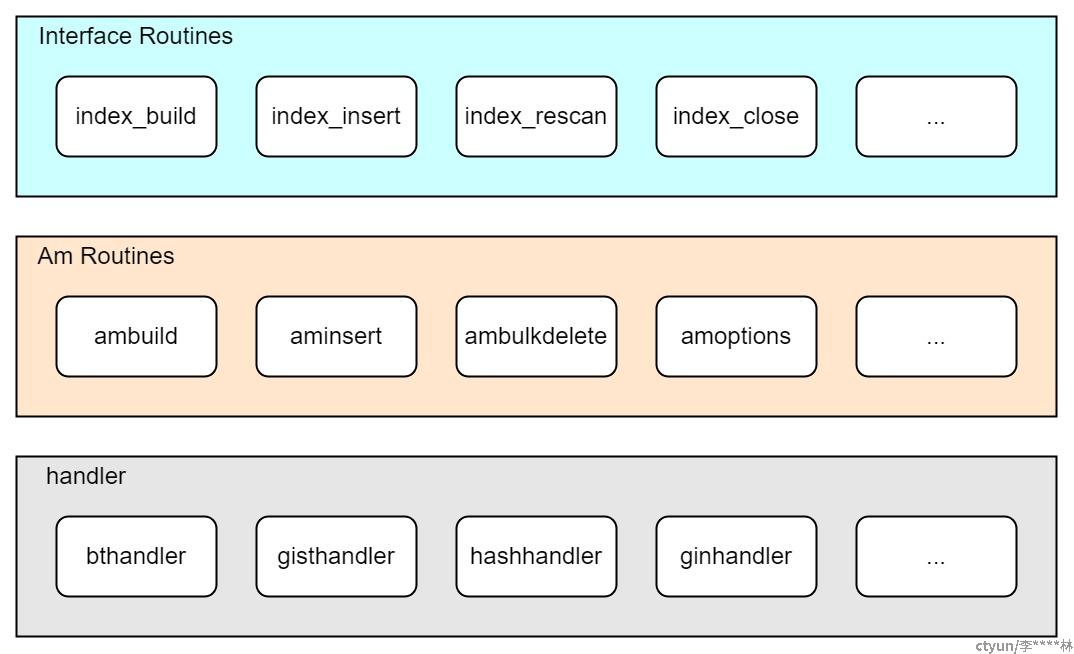
PG索引的下层接口函数。
|
ambuild
|
构建索引
|
|
ambuildempty
|
构造空索引
|
|
aminsert
|
向现有索引插入新的索引元组
|
|
ambulkdelete
|
从索引中删除元组
|
|
amvacuumcleanup
|
在一次VACUUM后执行,进行额外的清理,一般用于批量删除后
|
|
amcanreturn
|
判断能否返回一个索引元组
|
|
amcostestimate
|
估算一个索引扫描的代价
|
|
amoptions
|
分析和验证一个索引的reloptions数组
|
|
amproperty
|
给出索引的字段属性
|
|
ambuildphasename
|
返回amproperty所属阶段
|
|
amvalidate
|
验证运算符类的定义
|
|
ambeginscan
|
开始一个新的扫描
|
|
amrescan
|
重新扫描
|
|
amgettuple
|
在给出的扫描描述符里获取下一个元组
|
|
amgetbitmap
|
获取索引位图
|
|
amendscan
|
结束扫描,释放资源
|
|
ammarkpos
|
标记当前扫描位置
|
|
amrestrpos
|
把扫描恢复到最近标记的位置
|
|
amestimateparallelscan
|
估算索引并行扫描运算符的大小
|
|
aminitparallelscan
|
初始化并行扫描
|
|
amparallelrescan
|
重新并行扫描
|
以B树结构为例,btree对应的amhandler为bthandler,其中定义了B树结构索引需要实现得下层操作函数。btree索引的ambuild是btbuild,通过调用btbuild实现btree索引构建逻辑。
Datum
bthandler(PG_FUNCTION_ARGS)
{
IndexAmRoutine *amroutine = makeNode(IndexAmRoutine);
amroutine->amstrategies = BTMaxStrategyNumber;
amroutine->amsupport = BTNProcs;
amroutine->amcanorder = true;
amroutine->amcanorderbyop = false;
amroutine->amcanbackward = true;
amroutine->amcanunique = true;
amroutine->amcanmulticol = true;
amroutine->amoptionalkey = true;
amroutine->amsearcharray = true;
amroutine->amsearchnulls = true;
amroutine->amstorage = false;
amroutine->amclusterable = true;
amroutine->ampredlocks = true;
amroutine->amcanparallel = true;
amroutine->amcaninclude = true;
amroutine->amkeytype = InvalidOid;
amroutine->ambuild = btbuild;
amroutine->ambuildempty = btbuildempty;
amroutine->aminsert = btinsert;
amroutine->ambulkdelete = btbulkdelete;
amroutine->amvacuumcleanup = btvacuumcleanup;
amroutine->amcanreturn = btcanreturn;
amroutine->amcostestimate = btcostestimate;
amroutine->amoptions = btoptions;
amroutine->amproperty = btproperty;
amroutine->ambuildphasename = btbuildphasename;
amroutine->amvalidate = btvalidate;
amroutine->ambeginscan = btbeginscan;
amroutine->amrescan = btrescan;
amroutine->amgettuple = btgettuple;
amroutine->amgetbitmap = btgetbitmap;
amroutine->amendscan = btendscan;
amroutine->ammarkpos = btmarkpos;
amroutine->amrestrpos = btrestrpos;
amroutine->amestimateparallelscan = btestimateparallelscan;
amroutine->aminitparallelscan = btinitparallelscan;
amroutine->amparallelrescan = btparallelrescan;
PG_RETURN_POINTER(amroutine);
} 以创建索引为例,当执行
“create index xxx_idx on table(xxx);”时,索引创建流程如图所示。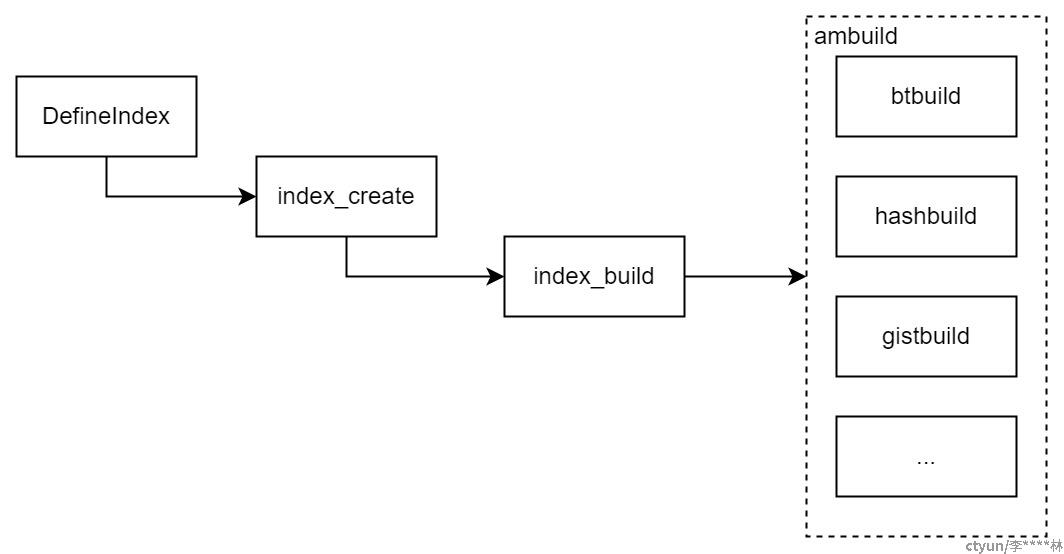
DefineIndex函数会创建索引相关结构体并校验相关参数合法性,其内部执行index_create函数。
Oid
index_create(Relation heapRelation,
const char *indexRelationName,
...
...
bool allow_system_table_mods,
bool is_internal,
Oid *constraintId)
{
Oid heapRelationId = RelationGetRelid(heapRelation);
...
...
char relkind;
TransactionId relfrozenxid;
MultiXactId relminmxid;
/* 参数检查初始化、操作符类检查、参数合法检查 */
Assert((constr_flags == 0) ||
((flags & INDEX_CREATE_ADD_CONSTRAINT) != 0));
Assert(!partitioned || (flags & INDEX_CREATE_SKIP_BUILD));
...
...
/*
* 构建用于描述索引元祖信息的结构
*/
indexTupDesc = ConstructTupleDescriptor(heapRelation,
indexInfo,
indexColNames,
accessMethodObjectId,
collationObjectId,
classObjectId);
/*
* OID检查,为索引生成新的OID
*/
if (!OidIsValid(indexRelationId))
{
if (IsBinaryUpgrade)
{
if (!OidIsValid(binary_upgrade_next_index_pg_class_oid))
ereport(ERROR,
(errcode(ERRCODE_INVALID_PARAMETER_VALUE),
errmsg("pg_class index OID value not set when in binary upgrade mode")));
indexRelationId = binary_upgrade_next_index_pg_class_oid;
binary_upgrade_next_index_pg_class_oid = InvalidOid;
}
else
{
indexRelationId =
GetNewRelFileNode(tableSpaceId, pg_class, relpersistence);
}
}
/*
* 在磁盘上创建索引文件,新建索引时relfilenode设置为和OID相同
*/
indexRelation = heap_create(indexRelationName,
namespaceId,
tableSpaceId,
...
&relfrozenxid,
&relminmxid);
...
...
/*
* 维护系统表pg_class、pg_attribute、pg_index、pg_constraint等
*/
InsertPgClassTuple(pg_class, indexRelation,
RelationGetRelid(indexRelation),
(Datum) 0,
reloptions);
...
...
/* 进入index_build真正构建索引结构 */
if (IsBootstrapProcessingMode())
{
index_register(heapRelationId, indexRelationId, indexInfo);
}
else if ((flags & INDEX_CREATE_SKIP_BUILD) != 0)
{
index_update_stats(heapRelation,
true,
-1.0);
CommandCounterIncrement();
}
else
{
index_build(heapRelation, indexRelation, indexInfo, false, true);
}
index_close(indexRelation, NoLock);
return indexRelationId;
} 调用index_build之前,索引相关元数据及系统表已插入,索引文件已创建,build根据pg_am中ambuild指定的索引构建函数执行创建流程。
void
index_build(Relation heapRelation,
Relation indexRelation,
IndexInfo *indexInfo,
bool isreindex,
bool parallel)
{
IndexBuildResult *stats;
Oid save_userid;
int save_sec_context;
int save_nestlevel;
/*
* 安全检查、环境检查、信息初始化等
*/
Assert(RelationIsValid(indexRelation));
Assert(PointerIsValid(indexRelation->rd_indam));
Assert(PointerIsValid(indexRelation->rd_indam->ambuild));
Assert(PointerIsValid(indexRelation->rd_indam->ambuildempty));
...
...
/*
* 调用下层接口ambuild创建索引
*/
stats = indexRelation->rd_indam->ambuild(heapRelation, indexRelation,
indexInfo);
Assert(PointerIsValid(stats));
...
...
AtEOXact_GUC(false, save_nestlevel);
SetUserIdAndSecContext(save_userid, save_sec_context);
}索引扫描
查询SQL执行
用户对数据库表格数据进行增删查改操作时,PG会解析这些语言后会生成一颗计划树用于执行查询。普通的增删改查命令由exec_simple_query函数处理,该函数会创建PortalData数据结构,Portal记录了该SQL执行的所有信息。对于普通的查询语句,Portal按照执行策略会选择Executor进行处理。

exec_simple_query函数中的PortalStart会调用ChoosePortalStrategy选取执行策略,并创建维护queryDesc信息,该结构中包含PlanState节点。实际上,PG的查询计划会被组织为树形PlanState,树的每个节点代表一个执行任务。
PG按功能将这些节点分为了控制节点、扫描节点、连接节点、物化节点。
扫描节点
所有扫描节点都使用Scan作为公共父类。
typedef struct Scan
{
Plan plan;
Index scanrelid; /* relid is index into the range table */
} Scan;PG中的扫描包含以下Scan类型。
T_ScanState,
T_SeqScanState,
T_SampleScanState,
T_IndexScanState,
T_IndexOnlyScanState,
T_BitmapIndexScanState,
T_BitmapHeapScanState,
T_TidScanState,
T_SubqueryScanState,
T_FunctionScanState,
T_TableFuncScanState,
T_ValuesScanState,
T_CteScanState,
T_NamedTuplestoreScanState,
T_WorkTableScanState,
T_ForeignScanState,
T_CustomScanState扫描节点有各自的执行函数,这些函数都由ExecScan来实现,ExecScan会迭代的进行扫描,使用accessMtd获取元祖。
IndexScan
当查询条件的属性存在索引时,则生成的查询计划中涉及的扫描会使用indexScan节点。
以下SQL为例,属性id存在索引id_idx。
select * from demo where id=xxx; 执行器中ExecutePlan函数处理查询计划,其主体是一个循环,直到检索到指定数量的元组。通过ExecProcNode执行任务,该函数会递归调用获取元祖。对于需要进行索引扫描的节点会调用ExecIndexScan执行。实际上ExecIndexScan会调用IndexNext检索元祖,IndexNext会调用至index_beginscan_internal函数,最终由ambeginscan选择对应结构的索引访问方法进行真正的扫描。其调用过程如图所示。
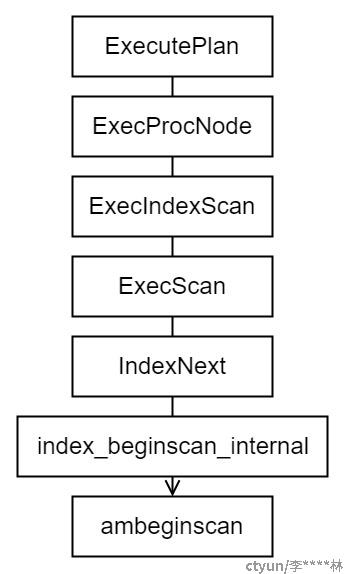
索引路径生成
当满足条件的元组较大时,索引扫描的代价会高于全表扫描,这时PG会选择全表扫描执行。
实际上,对查询SQL中的计划命令处理,无非是获取一个或多个元组,然后将这些元组返回给用户。对于一个执行计划来说,最重要的是如何获取元组。元组来源于一个基本表或一系列基本表连接而成的连接表。由于单表的访问方式、两个表的连接方式以及多表之间的连接顺序不同,因此可能有多条路径。需选取效率最高的路径作为执行计划。
exec_simple_query函数生成Portal之前会通过pg_plan_queries进行查询规划。该函数调用链如下。
exec_simple_query
-> pg_plan_queries
-> pg_plan_query
-> planner //优化器的入口函数,输入为经过重写后的查询树,输出最优的计划树
-> standard_planner //标准优化器入口
-> subquery_planner // 优化处理主体函数
-> grouping_planner // 不存在继承表的规划处理 pg_plan_queries会将查询树链表转换为执行计划链表,它调用pg_plan_query对每个查询树进行处理。planner函数开始会进入执行计划的生成阶段,通过standard_planner进入标准查询规划处理。subquery_planner递归调用为子查询生成相应子计划。后进入grouping_planner开始查询路径生成。
PG有三种算法生成路径:动态规划、遗传算法、用户自定义。
在生成路径时会遍历所有的关系生成不同的访问路径。query_planner会为查询生成路径。
-> query_planner // 为查询生成路径
// 获取RelOptInfo
-> add_base_rels_to_query // 递归找出基本表并生成基本关系
-> build_simple_rel // 构建表信息结构RelOptInfo
-> get_relation_info //补全RelOptInfo
...
-> make_one_rel
-> set_base_rel_pathlists set_base_rel_pathlists会为每个关系生成不同的访问路径。
static void
set_base_rel_pathlists(PlannerInfo *root)
{
...
...
set_rel_pathlist(root, rel, rti, root->simple_rte_array[rti]);
}
static void
set_rel_pathlist(PlannerInfo *root, RelOptInfo *rel,
Index rti, RangeTblEntry *rte)
{
......
switch (rel->rtekind)
{
//不同关系有不同的生成路径
case RTE_RELATION:
if (rte->relkind == RELKIND_FOREIGN_TABLE)
{
/* Foreign table */
set_foreign_pathlist(root, rel, rte);
}
else if (rte->tablesample != NULL)
{
/* Sampled relation */
set_tablesample_rel_pathlist(root, rel, rte);
}
else
{
/* 普通关系 */
set_plain_rel_pathlist(root, rel, rte);
}
break;
......
}
}
......
/* Now find the cheapest of the paths for this rel */
set_cheapest(rel);
} set_base_rel_pathlists实际调用set_rel_pathlis处理各种关系的路径,对于非子查询、无继承关系的查询称为普通关系,由set_plain_rel_pathlist处理。
static void
set_plain_rel_pathlist(PlannerInfo *root, RelOptInfo *rel, RangeTblEntry *rte)
{
Relids required_outer;
required_outer = rel->lateral_relids;
/* 添加顺序扫描路径 */
add_path(rel, create_seqscan_path(root, rel, required_outer, 0));
if (rel->consider_parallel && required_outer == NULL)
create_plain_partial_paths(root, rel);
/* 添加索引扫描路径 */
create_index_paths(root, rel);
create_tidscan_paths(root, rel);
} 首先会添加顺序扫描路径至pathlist中,若关系涉及索引将会建立索引扫描路径并加入到pathlist。但最终生成的路径不一定会保留在pathlist中,除非在代价或排序上更有优势。
以下为索引路径创建过程。
void
create_index_paths(PlannerInfo *root, RelOptInfo *rel)
{
...
foreach(lc, rel->indexlist)
{
IndexOptInfo *index = (IndexOptInfo *) lfirst(lc);
Assert(index->nkeycolumns <= INDEX_MAX_KEYS);
if (index->indpred != NIL && !index->predOK)
continue;
MemSet(&rclauseset, 0, sizeof(rclauseset));
match_restriction_clauses_to_index(root, index, &rclauseset);
get_index_paths(root, rel, index, &rclauseset,
&bitindexpaths);
MemSet(&jclauseset, 0, sizeof(jclauseset));
match_join_clauses_to_index(root, rel, index,
&jclauseset, &joinorclauses);
...
}
...
}
在生成索引路径之前通过match_restriction_clauses_to_index函数将索引与约束进行匹配。
create_index_paths
-> match_restriction_clauses_to_index
-> match_clauses_to_index
-> match_clause_to_index
-> match_clause_to_indexcol
-> match_opclause_to_indexcol match_opclause_to_indexcol负责将一个条件与索引列进行匹配。在生成路径前,查询中的条件操作符会被解析,通过操作符oid和opfamily的oid对pg_amop系统表进行查询。若查询为空则当前条件不能使用索引。
get_index_paths
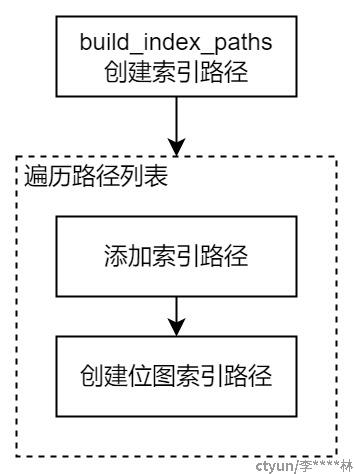
static void
get_index_paths(PlannerInfo *root, RelOptInfo *rel,
IndexOptInfo *index, IndexClauseSet *clauses,
List **bitindexpaths)
{
...
indexpaths = build_index_paths(root, rel,
index, clauses,
index->predOK,
ST_ANYSCAN,
&skip_nonnative_saop,
&skip_lower_saop);
...
foreach(lc, indexpaths)
{
IndexPath *ipath = (IndexPath *) lfirst(lc);
if (index->amhasgettuple)
add_path(rel, (Path *) ipath);
if (index->amhasgetbitmap &&
(ipath->path.pathkeys == NIL ||
ipath->indexselectivity < 1.0))
*bitindexpaths = lappend(*bitindexpaths, ipath);
}
...
} 位图扫描:当满足条件的数据行数很少时,使用索引扫描十分高效。但当满足条件的行数增加时,可能需要在多次访问同一个页面,并且在多个页面之间来回跳跃,而不是一次性将某个基表页面上满足条件的数据行全部读取出来,导致查询性能非最优。此时,优化器转而会使用位图扫描。
build_index_paths
static List *
build_index_paths(PlannerInfo *root, RelOptInfo *rel,
IndexOptInfo *index, IndexClauseSet *clauses,
bool useful_predicate,
ScanTypeControl scantype,
bool *skip_nonnative_saop,
bool *skip_lower_saop)
{
...
/* 1.处理SAOP */
for (indexcol = 0; indexcol < index->nkeycolumns; indexcol++)
{
...
if (index_clauses == NIL && !index->amoptionalkey)
return NIL;
}
...
/* 2.计算排序相关的优化 */
pathkeys_possibly_useful = (scantype != ST_BITMAPSCAN &&
!found_lower_saop_clause &&
has_useful_pathkeys(root, rel));
index_is_ordered = (index->sortopfamily != NULL);
if (index_is_ordered && pathkeys_possibly_useful)
{
index_pathkeys = build_index_pathkeys(root, index,
ForwardScanDirection);
...
/* 3. 覆盖索引 */
index_only_scan = (scantype != ST_BITMAPSCAN &&
check_index_only(rel, index));
/* 4.生成索引路径 */
if (index_clauses != NIL || useful_pathkeys != NIL || useful_predicate ||
index_only_scan)
{
ipath = create_index_path(root, index,
index_clauses,
...
false);
result = lappend(result, ipath);
...
}
}
/*
* 5. backwards scan 个人理解升序索引的降序排序处理。
*/
if (index_is_ordered && pathkeys_possibly_useful)
{
index_pathkeys = build_index_pathkeys(root, index,BackwardScanDirection);
useful_pathkeys = truncate_useless_pathkeys(root, rel,index_pathkeys);
if (useful_pathkeys != NIL)
{
ipath = create_index_path(root, index,
index_clauses,
NIL,
...
}
}
return result;
}create_index_path
IndexPath *
create_index_path(PlannerInfo *root,
IndexOptInfo *index,
List *indexclauses,
List *indexorderbys,
List *indexorderbycols,
List *pathkeys,
ScanDirection indexscandir,
bool indexonly,
Relids required_outer,
double loop_count,
bool partial_path)
{
IndexPath *pathnode = makeNode(IndexPath);
RelOptInfo *rel = index->rel;
/* 维护参数化路径的参数信息 */
pathnode->path.pathtype = indexonly ? T_IndexOnlyScan : T_IndexScan;
pathnode->path.parent = rel;
pathnode->path.pathtarget = rel->reltarget;
pathnode->path.param_info = get_baserel_parampathinfo(root, rel,
required_outer);
pathnode->path.parallel_aware = false;
pathnode->path.parallel_safe = rel->consider_parallel;
pathnode->path.parallel_workers = 0;
pathnode->path.pathkeys = pathkeys;
pathnode->indexinfo = index;
pathnode->indexclauses = indexclauses;
pathnode->indexorderbys = indexorderbys;
pathnode->indexorderbycols = indexorderbycols;
pathnode->indexscandir = indexscandir;
/* 计算索引代价 */
cost_index(pathnode, root, loop_count, partial_path);
return pathnode;
}代价估计需从I/O和CPU开销两个方面考虑。
void
cost_index(IndexPath *path, PlannerInfo *root, double loop_count,
bool partial_path)
{
IndexOptInfo *index = path->indexinfo;
...
/* 调用索引自身的代价估计函数计算启动代价、总代价、选择度、相关度 */
amcostestimate = (amcostestimate_function) index->amcostestimate;
amcostestimate(root, path, loop_count,
&indexStartupCost, &indexTotalCost,
&indexSelectivity, &indexCorrelation,
&index_pages);
/* 记录索引启动代价与运行代价 */
startup_cost += indexStartupCost;
run_cost += indexTotalCost - indexStartupCost;
/* 估算基表要取出的元组数 */
tuples_fetched = clamp_row_est(indexSelectivity * baserel->tuples);
if (loop_count > 1)
...
/* 估算最大最小IO代价 */
rand_heap_pages = pages_fetched;
max_IO_cost = (pages_fetched * spc_random_page_cost) / loop_count;
pages_fetched = ceil(indexSelectivity * (double) baserel->pages);
pages_fetched = index_pages_fetched(pages_fetched * loop_count,
baserel->pages,
(double) index->pages,
root);
min_IO_cost = (pages_fetched * spc_random_page_cost) / loop_count;
}
else
{
...
}
...
/* 根据最大最小代价和索引相关度计算总代价并加到运行代价中 */
run_cost += max_IO_cost + csquared * (min_IO_cost - max_IO_cost);
/* 估算CPU代价 */
cost_qual_eval(&qpqual_cost, qpquals, root);
startup_cost += qpqual_cost.startup;
cpu_per_tuple = cpu_tuple_cost + qpqual_cost.per_tuple;
cpu_run_cost += cpu_per_tuple * tuples_fetched;
...
/* 叠加出总代价并保存在path中 */
run_cost += cpu_run_cost;
path->path.startup_cost = startup_cost;
path->path.total_cost = startup_cost + run_cost;
} create_index_paths函数会通过add_path将索引路径添加至pathlist中。在添加时会将新路径与老路径进行比较,若新路径更优,则会保留新路径,删除老路径。
当普通关系路径构建完成后,通过set_cheapest函数设置代价最低路径。接着在外层make_one_rel中借由动态规划等算法生成最终路径。
总结以上流程。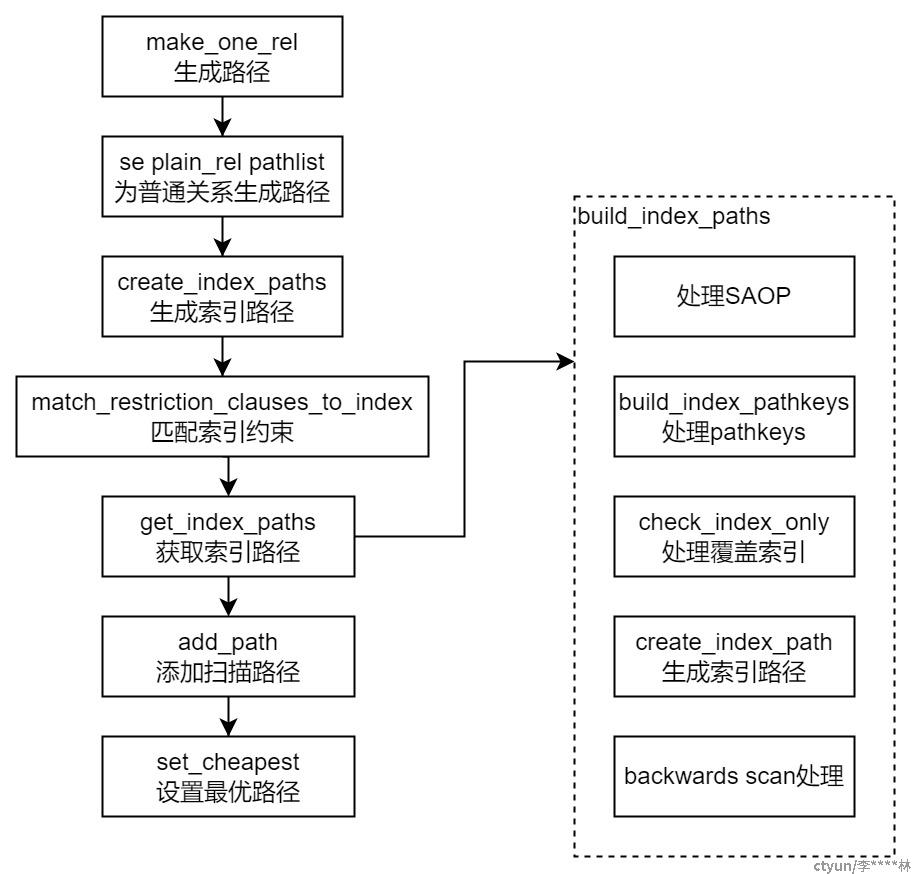

实际上在许多场景下,索引有着更复杂的优化,比如涉及表连接、子查询、排序、覆盖索引、位图扫描转换等。此处仅以一个简单的例子对索引的优化过程进行了分析。